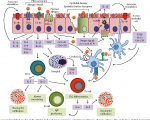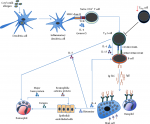
Fur Allergy
If you have fur allergy, you respond to allergenic substances that get stuck in the mucous membranes of the eyes, nose or lungs. The substances usually come from the animal’s saliva, urine or sebaceous glands but also fur. Most people who become allergic to fur animals get their first problems in childhood and adolescence.
The allergic disorders often decrease with age. It is not entirely clear why fur allergy starts, but it can be partly hereditary. The environment can also be important.

Pollen Allergy – Symptoms, treatments and medices
Pollen allergy, also called hay fever, causes problems such as red, itchy eyes, nasal congestion, repeated sneezing and runny nose. How severe the problems you get depends on how sensitive you are and how much and what types of pollen are in the air.
The pollen season lasts from early spring to late autumn and varies depending on where in the country you live. Prescription drugs can often alleviate the hassle, but not always completely remove them.

Lactose Intolerance
When you have lactose intolerance you have a reduced ability to absorb lactose, ie milk sugar from the food. This is because the intestinal mucosa has a lower level of an enzyme, lactate, which is required for the milk sugar to be broken down and taken up by the small intestine. With a lowered level of lactase, milk sugar will instead end up in the large intestine and will be broken down by bacteria, which can cause pain, diarrhea and gas formation.
Read More
Mite Allergy
Mite allergy causes problems such as red, itchy eyes, nasal congestion, repeated sneezing and runny nose. Mites are very small spiders found in the home. They are so small you can’t see them. In mite allergy, you react to allergenic substances that mites produce. They thrive in humid, dark and warm climates and are often difficult to get rid of.
The type of mites that cause problems in the home is called house dust mites. They are mainly in bed.

Cow’s milk allergy
Cow’s milk allergy means that you are allergic to one or more proteins found in the milk. Allergy is most common in children younger than one year. Most often the allergy goes away before the child starts school. Some have left the allergy as adults. The treatment is to avoid diets containing cow’s milk.
Cow’s milk allergy is most common in children younger than one year. You may have cow’s milk allergy as an adult, but it is unusual.

Peanut allergy and nut allergy
The nut allergy reaction often comes within a few minutes, nut allergy symptoms are itching in the mouth and swelling around the eyes
Read More
Insect Allergy
In the case of insect allergy, you are allergic to any substance in the poison that insects inject when they stick with their spikes.
Read More
Fragrance Sensitivity
In case of fragrance sensitivity, you get coughing, and runny eyes from, for example, cigarette smoke, exhaust fumes, scented flowers, and perfume.
Read More
Food and Cooking with celiac disease
What can I eat? in food for celiac disease? There are also special products such as gluten-free pasta, gluten-free cereals, and gluten-free bread.
Read More
Celiac disease – Gluten Intolerance
Celiac disease compensations for the villi, leaving your body incapable to absorb nutrients required for health and growth. Celiac disease is a resistant reaction to eating gluten, a protein found in wheat, barley, and rye.
Read More